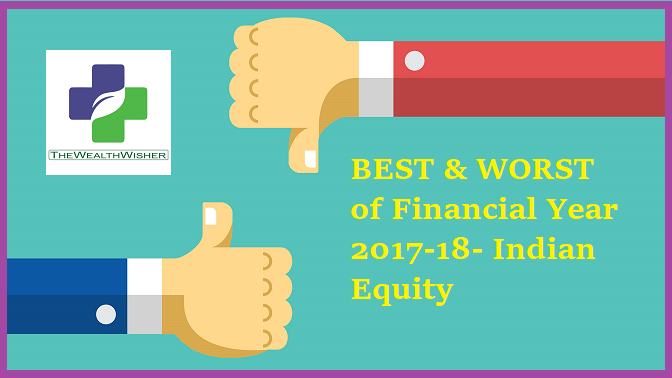It’s April and start of a new financial year. Many things will change as change is welcome. Changes when happen they becomes history and there are some valuable lessons for investors when you see historical figures. Here are recap and lessons learned from the Best & Worst of Financial Year 2017-18.
One year figures are not exactly history if you look at investing. One year is just a bucket of water fetched out of the flowing river. So we are going to just see what we can learn by analyzing one-year data. We are not saying or indicating any trends. We are just trying to learn or relearn some basic facts. So best & worst will amuse you but you need to look at missing lines.
Last financial year will be remembered as the year of awakening. Yes, you, me, our friends, family neighbors everyone has invested in equity. Data shows the highest number of money in history that has come to markets. This year we saw:
- The highest number of equity inflows in mutual funds.
- A record number of new DEMAT accounts opened.
- Rs 6200 plus per month in SIPs.
- Highest amount ever collected in IPOs (Initial Public Offers).
So it all looks very beautiful, Isn’t it? So why a worry on your forehead?
Is this what bothers?

Well, this year all these great numbers hide a fact – Volatility. The market never stood in a range. It kept revolving.
It was a volatile 12-month period for the Indian equity markets as after signing off the calendar year 2017 on a high.
Best & Worst of Indian Market in 2017-18

By Sept 2017, all said valuations have reached the peak. But came October 2017 everyone was happy as markets did not oblige to come down. Came December and it ignored Gujrat Elections, North Korean Aggressive stand & of course the valuations.
Came January, finally markets corrected in last quarter.
Banking Scam, International markets correction, Fed increasing rate etc… etc created a havoc for the fearful.
Crude oil prices, which rose approximately by 30% in the fiscal year, were also one of the major concerns. Implementation of Long Term Capital Gains tax, overshooting fiscal deficit, the constant unveiling of fraud in the banking system coupled with rising NPAs… You count I can go on…
Lesson
Markets are not bounded by calendar or fiscal year. They have cycles and they have nothing against your portfolio or for your portfolio. They have no dates. We give them references like a quarter, year, FY or dates. The basic rule is equity means riding for more than one cycle. Investment should continue, if you can. Do not time. Read fundamentals if you want to keep busy. Playing by buy & selling to look “active” is a futile exercise.
Best & Worst of Stocks: Stocks that gained

Stocks that lost

Lesson
Its fundamentals that matters. Look at Sintex. We all know, there is a huge thrust on building homes for all. Cities have lined up themselves to be called “cleanest cities”. Look at Indore, Jaipur or Nagpur. Statement governments have bought and forced lakhs of shopkeepers to buy green & blue dustbins. All from Sintex. But stock lost this year. Does this mean it is a bad stock? Or just emotional atyachar by speculators?
International Market
Nifty under-performed not only against the developed markets like the Dow Jones and Nasdaq but also was beaten by its Asian peers like Nikkei in Japan and Hang Seng in Hong Kong.
You can hate US, but you cannot ignore it if you are an investor. Blame its trade, economic, dollar web but markets are sensitive to it. US markets had one of the best years but it lost steam in the end.
What PNB & PSU stocks did to India, Facebook did to the US.
Lesson
Volatility has only one fodder- Information. Markets react to news. International factors are just a name or type of food markets live on. Like any other factor, International News particularly coming from developed world will impact flows of developing nations. They have the key (more than 40 billion) which if moves, we will have jitters.
IPOs
Highest all time never means – It’s a good thing or all sins have turned pious.

Lesson
IPOs have totally become irrelevant if you are a long-term investor. They are priced high, majority buy to get even high rates & they exit the bus on the listing. So this is not listing it is dumping and trading. Seriously this instrument needs the attention of regulators to cleanse the rotten part.
Fixed Income
The 10-year bond, just 3 days ago came to a respectable figure otherwise, very few had clue what was happening. A huge correction year and very confusing for people who do want to invest in equity and not happy with bank rates.

Lesson
 Last year a chunk of FD money went into balance funds. This money is facing equity volatility. It looks like expectations will burst here if the market volatility continues. One must know the asset class he is investing in. Money in debt cannot be replaced by equity. One must know his asset allocation. You cannot deviate. One deviation means now you are in hands of future and this is speculation.
Last year a chunk of FD money went into balance funds. This money is facing equity volatility. It looks like expectations will burst here if the market volatility continues. One must know the asset class he is investing in. Money in debt cannot be replaced by equity. One must know his asset allocation. You cannot deviate. One deviation means now you are in hands of future and this is speculation.
Hope these lessons & pictures will resonate in your minds in the coming financial year.
Feel free to reach me if you are in doubt.
Share and comment what you feel on this article on Best & Worst of FY 2017-18.











